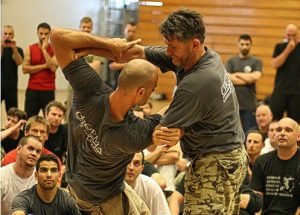More specifically, Short Work is the result of the opponents’ tension and relaxation. In a confrontation, your attacker is either tense and you need to see where or you can force him to tense up wherever you need him to. Then you bounce your strikes and movements off his tension. This allows you to deliver multiple strikes all in one movement. For example, you deliver a punch and your arm does not stop or pause upon contact, it does not return back towards your body but continues to travel and deliver more strikes in various directions.
There is a great benefit in learning Short Work, for it allows you to defend from multiple opponents. It enables you to do multifunctional work – defence, offence, redirection and stopping of attacks.
The more tension the opponent has the faster your short work can be. But this does not mean that punches are quick and light, in Short Work the punches are heavy and strong.
Proper Short Work is precision in any direction, where for instance, you can tense up a part of your arm or move it regardless of the position and tension in the rest of your body.
It is extremely hard for the opponent to defend against Short Work. It has a devastating effect on a tense body. The only way to handle Short Work is to eliminate tension.
Vladimir Vasiliev
It includes movements of minimal quantity and amplitude yet of top precision and power.
Short work is the opposite of moving around a lot, waving, long, broad, fidgety and redundant movements. Instead, movements are concise and calm, contact with the target is instantaneous, with pin-point accuracy and great strength.
Short work usually seems subtle to the observers and comes unexpectedly to the attacker.
The physical effort to apply short work should be minimal, while the efforts to achieve this level of skill are significant. Systema practitioners gain this skill through learning to control their physical and psychological tension, correct body placement, dynamic breath patterns, developing power-filled fists, freedom of movement, tactical diversity, and other key Systema features.
Mikhail Ryabko

